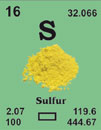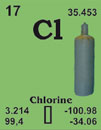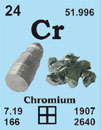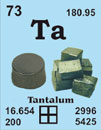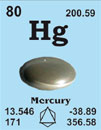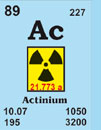Tantalum 73Ta180.948
Discovered in 1802 by A.G. Ekeberg at Uppsala, Sweden.
[Greek, Tantalos, father of Niobe of Greek mythology]
French: tantale
German: tantal
Italian: tantalio
Spanish: tántalo
Description: Tantalum is a shiny, silvery metal which is soft when pure. It is very resistant to corrosion due to an oxide film on its surface, but is is attacked by HF and molten alkalis. Tantalum is used in electronics, cutting tools, chemical plants and surgery.
Tantalum single crystal properties
| State: |
Single crystal |
|---|
| Crystal structure: |
bcc |
|---|
| Production method: |
Floating zone |
|---|
| Standard size: |
diameter 6-12mm
thickness 1-2mm |
|---|
| Orientation: |
(100), (110) and (111) |
|---|
| Orientation accuracy: |
<2°, <1°, <0.4° or <0.1° |
|---|
| Polishing: |
as cut, one or two sides polished |
|---|
| Roughness of surface: |
<0.03µm |
|---|
| Purity: |
99.99% |
|---|
| Typical analysis (ppm): |
C 3
H < 1
O 9
N < 5
Cu 1.60
Fe 1.80
Ni < 1
Pb 0.30
Si 0.30
Ga, Hf and Ta are below the detection limit
|
|---|
Materials properties
| Density: |
16.6 g/cm3 |
|---|
| Melting point: |
2995.85 °C / 3269 °K |
|---|
| Boiling point: |
5424.85±100 °C / 5698±100 °K |
|---|
| Molar volume: |
10.87 cm3 |
|---|
| Thermal conductivity: |
57.5 [300 K] Wm-1K-1 |
|---|
| Coefficient of linear thermal expansion: |
6.6 x 10-6 K-1 |
|---|
| Electrical resistivity: |
12.45x 10-8 [298 K] Wm |
|---|
| Mass magnetic susceptibility: |
+1.07 x 10-8(s) kg-1m3 |
|---|
| Young's modulus: |
185.7 GPa |
|---|
| Rigidity modulus: |
69.2 GPa |
|---|
| Bulk modulus: |
196.3 GPa |
|---|
| Poisson's ratio: |
0.342 |
|---|
| Radii: |
Ta5+ 64; Ta4+ 68; Ta3+ 72; atomic 143; covalent 13 |
|---|
| Electronegativity: |
1.5 (Pauling); 1.33 (Allred); 4.11 eV (absolute) |
|---|
| Effective nuclear charge: |
3.30 (Slater); 9.53 (Clementi); 13.78 (Froese-Fischer) |
|---|
| Number of Isotopes (incl. nuclear isomers): |
28 |
|---|
| Issotope mass range: |
159 -> 186 |
|---|
| Crystal structure, (cell dimentions / pm), space group |
bcc |
|---|
| X-ray diffraction: mass absorption coefficients: |
CuKα 166 (µ/r) / cm2g-1
MoKα 95.4 (µ/r) / cm2g-1 |
|---|
| Neutron scattering length: |
0.691 b/10-12 cm |
|---|
| Thermal neutron capture cross-section: |
20.6 sa / barns |
|---|
Biological data
| Biological role: |
none |
|---|
| Toxicity |
|
|---|
| Toxic intake: |
moderately poisonous by ingestion |
|---|
| Lethal intake: |
LD50 (chloride, oral, rat)= 1900 mg kg-1 |
|---|
| Hazards: |
There are no cases of industrial poisoning caused by tantalum or its compounds. However, it is an experimental tumorigen. |
|---|
| Level in humans |
|
|---|
| Blood: |
n.a., but low |
|---|
| Bone: |
c. 0.03 p.p.m. |
|---|
| Liver: |
n.a. |
|---|
| Muscle: |
n.a., but low |
|---|
| Daily dietary intake: |
0.001 mg |
|---|
| Total mass of element in average [70 kg] person: |
c. 0.2 mg |
|---|
Geological data
| Mineral | Formula | Density | Hardness | Crystal apperance |
|---|
| Columbite |
(Fe, Mn)(Ta, Nb)2O6 |
a group of |
Ferrotanta |
FeTa2O6 |
|---|
| 7.95 |
6 - 6.5 |
orth., bla |
Manganotan |
(Fe, Mn)(Ta, Nb)2O6 |
|---|
| 6.76 |
6 - 6.5 |
orth., bla |
Microlite |
(Na, Ca)2Ta2O6(O, OH, F) |
|---|
| 6.42 |
5 - 5.5 |
cub., vitr |
Samarskite |
(Y, Ce, U, Fe)3(Nb, Ta, Ti)5O16 |
|---|
| 5.69 |
5 - 6 |
orth., vit |
Chief ore: |
columbite, samarskite |
|---|
| Chief ore: |
columbite, samarskite |
|---|
| World production: |
840 tonnes/year |
|---|
| Main mining areas: |
Australia, Zaire, Brazil, Russia, Norway, Canada, Madagascar; mostly obtained as a by-product of tin extraction. |
|---|
| Reserves: |
n.a. |
|---|
| Specimen: |
available as foil, powder, rod or wire. Safe. |
|---|
| Abundances |
|
|---|
| Sun: |
n.a. (relative to H = 1 x 1012) |
|---|
| Earth's crust: |
2 p.p.m. |
|---|
| Seawater: |
|
|---|
| Residence time: |
|
|---|
| Classification: |
|
|---|
| Oxidation state: |
V |
|---|
Source: Emsley, J. (1998) The Elements (3rd Edition)

 English
English
 Deutsch
Deutsch
















